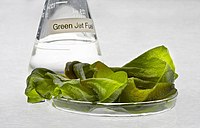
Photo from wikipedia
Abstract A submerged membrane photobioreactor was tested to provide a feasible means to conduct tertiary treatment of livestock wastewater. In this study, three phases of a semi-continuous photobioreactor were tested… Click to show full abstract
Abstract A submerged membrane photobioreactor was tested to provide a feasible means to conduct tertiary treatment of livestock wastewater. In this study, three phases of a semi-continuous photobioreactor were tested based on hydraulic retention time to evaluate biomass productivity, effluent quality, and fouling characteristics of the membrane module. The results show that the membrane module contributes to securing effluent quality with high nitrogen (36%) and phosphorus (25%) daily removal rates. Shorter hydraulic retention time resulted in better performance for removal of nitrogen and phosphorus; a 3 d hydraulic retention time resulted in 96% (nitrogen), and 85% (phosphorus) removal. Under the proposed condition, the biomass concentration simultaneously increased to 3500 mg/L (dry weight). Active photosynthesis in the photobioreactor was strongly associated with the average concentrations of soluble microbial products (carbohydrate: 84.5 mg/L, protein: 37.9 mg/L) and extracellular polymeric substances (carbohydrate: 44.1 mg/L, protein: 556.9 mg/L). Relatively high carbohydrate concentrations in the permeate provided evidence of a strong relationship between the effluent quality and carbohydrates in the soluble microbial products. Morphological and chemical analyses proved that micro-algal membrane fouling is attributable to soluble microbial products and/or extracellular polymeric substances. These occur in significant amounts after 10 d, indicating an unavoidable need for biomass harvesting. This study provides an understanding of the fouling trend according to varying hydraulic retention time and biomass harvesting, and offers a viable operation strategy for use of a submerged membrane photobioreactor to convert pollutants into useful bioresources and improve effluent quality.
Journal Title: Journal of Cleaner Production
Year Published: 2018
Link to full text (if available)
Share on Social Media: Sign Up to like & get
recommendations!